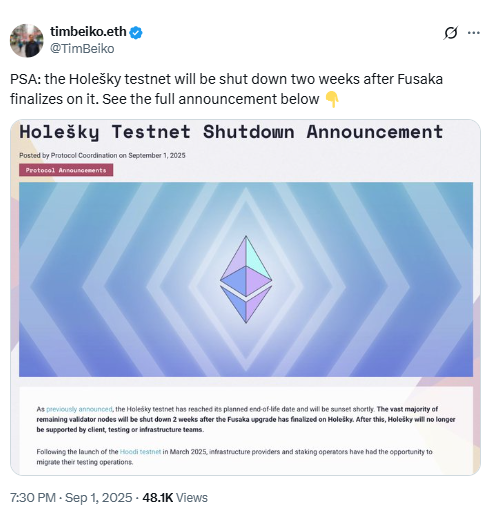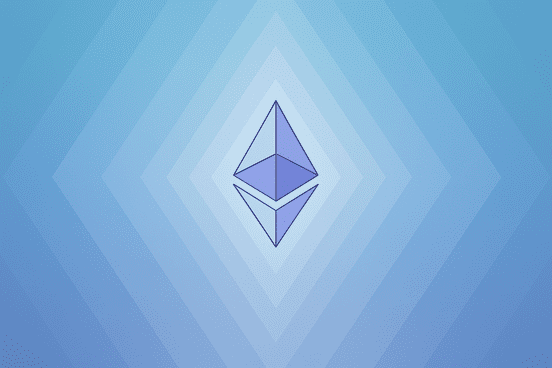Ethereum Foundation will shut down its largest testnet, Holešky, two weeks after the upcoming Fusaka upgrade.
The upgrade is expected in the second half of September 2025, and the shutdown will happen before Fusaka goes live on mainnet in November.
Holešky launched in September 2023. It was used to test Ethereum’s staking infrastructure and validator operations.
The testnet helped developers simulate large-scale upgrades, including the Dencun and Pectra hard forks.
According to the announcement,
“Holešky will no longer be supported by client, testing or infrastructure teams.”
The shutdown follows earlier technical issues in 2025. The network experienced long periods of inactivity leaks, which led to a large validator exit queue.

Holešky was the main Ethereum testnet for staking after Goerli. It supported thousands of validators for pre-mainnet testing. After the sunset, developers will need to migrate their staking infrastructure to another network.
Hoodi Testnet to Replace Holešky for Ethereum Validator Testing
The Ethereum Foundation launched a new testnet called Hoodi in March 2025. It serves as a replacement for Holešky and aims to provide a clean environment for testing validator infrastructure.
Hoodi already supports the Pectra upgrade and will also include future protocol changes, such as Fusaka. The foundation has started moving all staking operators and test infrastructure from Holešky to Hoodi.
Hoodi was introduced after Holešky faced stability issues, including excessive inactivity and validator exits. Although the network recovered, the problems pushed developers to build a new environment.
For now, Ethereum recommends using Sepolia for testing smart contracts and decentralized applications. Hoodi will focus on validator and protocol-level experiments.
Fusaka Fork Set for November, Includes 11 Ethereum Improvement Proposals
Ethereum’s next major upgrade is the Fusaka fork. It combines two codenames: Fulu and Osaka. The hard fork is planned for early November 2025.
Fusaka will introduce 11 Ethereum Improvement Proposals (EIPs). These changes aim to spread data availability workloads more evenly across Ethereum’s validator set. The goal is to make it easier for layer-2 rollups to access data.
The upgrade is expected to reduce load on individual nodes, which could help improve scalability and network decentralization. Fusaka will roll out on testnets like Hoodi before it hits Ethereum mainnet.
Developers are finalizing testing timelines to meet the November launch target. Once Fusaka is deployed, the Ethereum team will shift focus to the next upgrade cycle.
Glamsterdam Upgrade Planned for 2026, Focuses on Block Times
Ethereum’s future upgrade Glamsterdam is set for 2026. It will include EIP-7782, which proposes reducing block times from 12 seconds to 6 seconds.
The proposal also plans to split block validation from execution. That will give zkEVM provers more time to generate zero-knowledge proofs. These changes are part of Ethereum’s long-term technical roadmap.
Ladislaus from Ethereum’s protocol coordination team shared details in July 2025. He explained the goal is to create more flexibility for proof systems without altering execution outcomes.
The timeline for Glamsterdam has not been confirmed. Developers continue research and discussion around performance and consensus mechanics.
Ethereum Infrastructure Expands, ETH Treasuries Grow
Ethereum’s latest upgrades have coincided with increased interest in Ether (ETH) from public companies. Several firms have added ETH treasuries in recent months.
Since April 2025, the price of ETH has increased over 200%, partly due to deflationary tokenomics, staking yields, and more usage in corporate settings.
The Ethereum Foundation also named user experience (UX) as a major focus for the next 6–12 months.
That includes updates to infrastructure, wallets, and transaction flow to help both developers and users.
Disclosure:This article does not contain investment advice or recommendations. Every investment and trading move involves risk, and readers should conduct their own research when making a decision.
Kriptoworld.com accepts no liability for any errors in the articles or for any financial loss resulting from incorrect information.

Tatevik Avetisyan is an editor at Kriptoworld who covers emerging crypto trends, blockchain innovation, and altcoin developments. She is passionate about breaking down complex stories for a global audience and making digital finance more accessible.
📅 Published: September 2, 2025 • 🕓 Last updated: September 2, 2025


